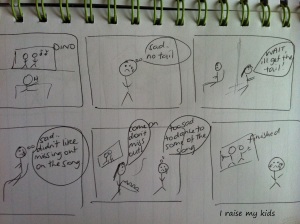Coping with disappointment is related to ‘difficulty adapting to change’, when a change happens that the child wasn’t expecting! Spirited children find it even harder to cope with change and disappointment as they go into almost a flight/fight/freeze reaction where they cannot think logically or clearly.
Master 3 had been watching Playschool, one of his favourite dinosaur episodes and always loved to dance to the dinosaur songs with his dino tail on. Unfortunately, if the tail isn’t on as the song begins, a meltdown occurs. It is easy to say ‘calm down’, ‘you’ve missed TWO seconds of the song, don’t worry’, but Master 3 has ‘flipped his lid‘ (as The Whole Brain Child calls it) and he cannot think clearly or logically from then on. No matter what we do!
So! One day, having had enough of it, I announced we were doing a drawing to set Master 3 up for success the next time. This time was lost, but at least I could prepare his brain better for next time, before he had another ‘dino meltdown’!
If you haven’t already, you can also refer to When in doubt, say it with a pen! for a run-down on the benefits of drawing with your child 🙂 This is how this drawing went…
First

the meltdown
Square 1. Master 3 watching Playschool
2. I asked how Master 3 felt in this scenario – he responded ‘sad’ so I prompted ‘but what made you sad’ to get him talking more – ‘no tail’.
3. I drew Mummy running to get the tail but Master 3 still crying.
4. I asked Master 3 how he felt after Mummy went to get his tail – he responded ‘sad, I didn’t like missing out on the song (without the tail on)’
5. So I drew Mummy trying to give him the tail so we could go back to that part to talk about it more, as Master 3 just couldn’t calm down even though he had the tail and the song was still going. He responded ‘too sad to dance to some of the song’. His words.
6. We finished the drawing with how the scenario ended, Master 3 still upset.
Second

take 2 – the fairytale version
Square 1. I started the drawing with ‘Master 3 is happy his dino song is on!!’ and drew a happy face to start the drawing. This had Master 3 laughing just thinking about it, almost relieved he didn’t have to get upset. I asked him what he needed to say – he came up with ‘mummy get my tail please!’. Nice.
2. I wrote what Master 3 might say ‘put it on quick, I’ll dance to some of it, with my tail’.
3. Master 3 again, so happy to see himself happy and dancing at the end of this story. We compared with the ending of story 1.
Third

the what if version
The most important part – thinking about what variations of the fairy tale version might happen, so we don’t get another surprise next time! Mental practice for the not-so-planned times is SO helpful for children who don’t cope with change and disappointment well. Knowing that Master 3 was primed for me to put his tail straight on, we talked about what happened if the tail wasn’t right there in the room.
Square 1. ‘Mummy get my tail please’
2. Mummy running for the tail – the key point here – Master 3 still SMILING!
3. I asked Master 3 what he would do in the meantime – ‘I might dance until my tail comes’. He’s getting it!
4. Mummy putting the tail on – Master 3 still happy (‘not like that first story!!’)
5. Hooray, Master 3 is STILL happy.
The other day, we had success! Master 3 stayed calm and said to Master 1 ‘You just dance and mummy will get a tail for you’.

problem solved!!!!
Catch us on Facebook – I raise my kids 🙂








![IMG_4494[1]](https://iraisemykids.wordpress.com/wp-content/uploads/2013/06/img_44941.jpg?w=224&h=300)